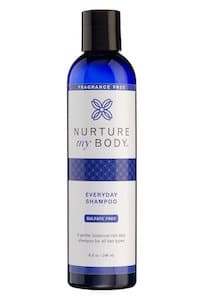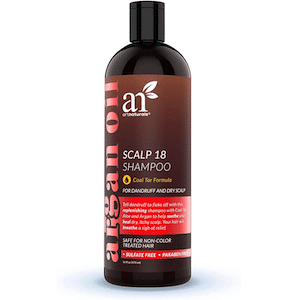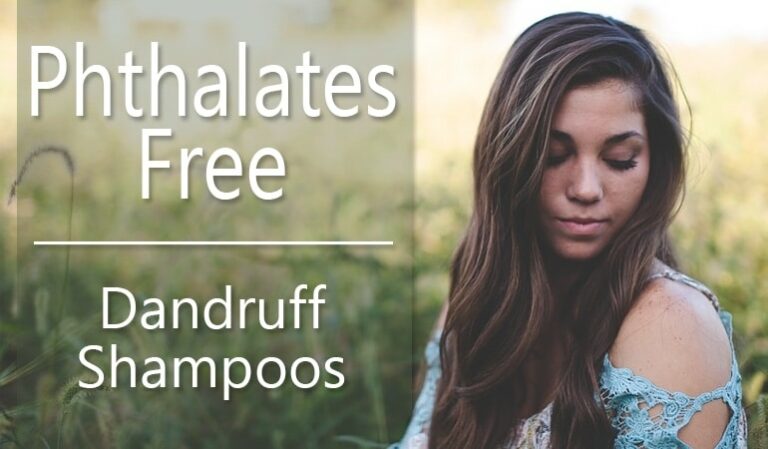Dandruff Deconstructed is reader-supported. All reviews are independent and any products reviewed are purchased by the site owner. To help fund this model, some of the links on the site are affiliate links. If you decide to make a purchase from one of these links, this site will receive some commission. At no cost to you. It helps keeps this place running. Learn more
Phthalates are chemicals used in everything from cleaners to fragrance to cosmetics to and personal-care products.
And yes, they are used in shampoos.
Phthalates have also garnered significant levels of controversy in recent years. Toxicological studies have shown that phthalates can be harmful, and regulatory authorities have taken a strong stance.
With the internet being what it is, the chemical has turned into a bit of a bogey man blamed for everything from asthma to adht to cancer to male infertility. The misinformation is strong with this one.
But is the reputation deserved?
In true Dandruff Deconstructed fashion, we’ll look beyond the hype, review the evidence, study the regulatory decisions, and let you decide for yourself if you want to continue using products that contain the chemical.
We’ll then recommend viable alternatives as well as listing the best Phthalates Free Dandruff Shampoos on the market today.
What are Phthalates?
Phthalates (pronounced with the ph silent – thalate) are plasticisers used by the cosmetics industry to increase the flexibility and durability of conditioning coatings [1]. They are ‘diesters’ of 1,2-benzenedicaraboxylic acid – more commonly known as phthalic acid – and can be found in a range of industrial and household products, including: shampoos, nail varnishes, perfumes, vinyl floor tiles, garden hoses, and adhesives [2].
Phthalates have been used since the early 1930s, and millions of tonnes are now manufactured every year [3]. They can be split into two broad categories depending on their chemical structure: ‘low molecular weight’ (LMW) and ‘high molecular weight’ (HMW). Only LMW phthalates are typically found in shampoos, with some common names to look out for:
- di(2-ethylhexyl) phthalate (DEHP)
- dimethyl phthalate (DMP)
- dietyl phthalate (DEP)
- butylbenzyl phthalate (BBzP)
In addition to altering the texture and consistency of the shampoo, Phthalates can also be used as a solvent to dissolve other shampoo ingredients.
And, amazingly enough given the controversy, Phthalates are often added to the fragrance of a shampoo. Do you know the smell of smell of a new vinyl shower curtain? That’s the smell of phthalates right there.
What are the risks?
Phthalates are found in many cosmetics, as well as many household products, and so concern has been raised about the harms of accumulation. The main risks are from inhalation and skin contact, resulting in irritation and contact dermatitis [4]. Major phthalate metabolites have been found in urine, indicating that systemic absorption is common [5].
The evidence for the risks of phthalates is mostly based on rodent studies – testing potentially harmfully substances on humans is generally frowned upon. Low doses of phthalates in animals have been shown to cause: testicular toxicity leading to infertility; steroid disruption affecting the ovaries; hepatocellular adenoma and pancreatic cancer; and airway remodelling correlating with asthma [6].
The mechanism by which phthalates cause so much disruption is thought to be through activation of ‘peroxisome proliferator-activated receptors’ (PPARs) – which help to regulate which genes are switched on and off. It has been suggested that the higher concentration of PPAR in rats compared to humans is one of the reasons why so many harmful effects have been observed in animal studies [7].
How are they regulated?
The risks of phthalates are still not fully understood, but the numerous animal studies have prompted regulatory authorities to impose restrictions on their use. In 2008 the European Union (EU) produced a 588 page ‘Risk Assessment Report’, which indicated that there was a need to reduce the risk to consumers [8]. A 2012 amendment to 1999 regulations prohibit LMW phthalates from being manufactured in the EU without specific permission, and concentrations cannot exceed 0.1% [9].
Are Phthalates listed in my shampoos?
According to the FDA, Phthalates must be declared on their list of ingredients. Unless it’s added as a fragrance, and then it doesn’t. While this may seem incredible, it’s the same in the EU.
If you want to avoid Phthalates completely, the only way to be sure if to avoid all products with Fragrance in the ingredients list.
It’s an astonishing situation.
On the FDA’s own site, only approx. a third of hair care products contained Phthalates in their fragrances, but the only way to totally avoid Phthalates completely is to not use the other two thirds as well. How is this so in 2017?
Some products are listed as Phthalates Free but I have seen a handful in the last few years.
That said, while avoiding all shampoos that contain fragrance and phthalates may seem a daunting task, you can use our search tool to find all shampoos contain neither fragrance or phthalates.
Simply select what is causing your dandruff, indicate that you wish to avoid Fragrance and Phthalates (as shown below) and press Search.

Are there any alternatives?
The bad press around phthalates has prompted some companies to move away from their use. Plasticisers are required in shampoos that also include glycols and other polymers – offering beneficial qualities like conditioning, lather, and luxurious feel.
The specific chemical properties of plasticisers prevent there being a readily available ‘natural’ alternative but some ‘less harmful’ options include:
- Acetyltributylcitrate (ATBC)
- Di-isononylcyclohexane-1, 2-dicarboxylate (DINCH)
Neither ATBC nor DINCH have been associated with the kind of harmful toxicities observed with phthalates, and are generally less irritating. They are also less frequently used, and so the main concern of phthalates – accumulation – is a significantly lower [10]. More research is needed to find natural alternatives, but in their absence, moving away from phthalates to ATBC, DINCH, and other plasticisers is a positive step.
The best Phthalates Free Dandruff Shampoos
Note, this list contains all shampoos that are free of Phthalates listed on the ingredients. Some of the shampoos may contain Phthalates hidden as a fragrance. if you want to be absolutely sure your products are Phthalates free, you will have to use our search tool and search for Fragrance and Phthalates free shampoos.

Pharmaceutical Specialities Free & Clear Shampoo
Designed to treat Seborrheic Dermatitis, Dry Scalp and Psoriasis
Pharmaceutical Specialties formed in 1974 to “start a company to make better products than were commercially available for people with sensitive skin”. And boy, have they achieved it with this Free and Clear shampoo.
What is perhaps surprising on a website dedicated to dandruff treatments is that this isn’t a dandruff shampoo at all.
It’s rather a "a non-medicated, mild shampoo for sensitive skin and scalp.”
That said, we can’t use a medicated shampoo all the time, and this is my go to shampoo for those “between” washes.
Read the entire review

BIOM8 Skin Conditioning Oil
Designed to treat Seborrheic Dermatitis, Dry Scalp
BIOM8 Skin Conditioning Oil is now part of my daily skin care routine. It’s as simple as that. I have lost count of the number of products I’ve reviewed over the years and I can count on one hand the number of products that have impacted me on this level.
If you suffer from dry skin, facial seb derm or rosacea I simply can’t recommend this product highly enough.
It even makes a good beard oil!
Read the entire review


Maple Holistics Hydrate Shampoo
Designed to treat Dry Scalp
Maple Holistics Hydrate Shampoo has been superbly formulated to soothe and moisturize the scalp and hair. The ingredients have been carefully selected to decrease the chance that the product will irritate the skin. Using multiple low dose surfactants is a stroke of genius and only the fact the shampoo contains only one potential contact allergen says it all.
This is as close to perfection as you get in the commercial shampoo world.
I simply can't recommend this highly enough.
Read the entire review


Nurture My Body Everyday Fragrance Free Shampoo
Designed to treat Dry Scalp
Nurture My Body Everyday Fragrance-Free Shampoo is an excellent gentle option for sufferers of a dry irritated scalp. The absence of any noteworthy irritants or allergens combined with the expert formulation of anti-inflammatory moisturizing ingredients makes an excellent change from the usual harsh surfactants and other toxins that lead to a vicious cycle of irritation and inflammation.
They've managed all of this in a shampoo that foams and washes well.
It's not particularly cheap, but this is simply one of the finest dry scalp shampoos out there.
Read the entire review


Sebclair Shampoo
Designed to treat Seborrheic Dermatitis, Dry Scalp
Calling all sensitive scalp sufferers, if you haven’t yet found an anti-dandruff shampoo your scalp can tolerate, you haven’t yet found Sebclair shampoo. A piroctone olamine, Malassezia yeast quelling formula with extremely mild yet highly effective cleansers, accompanying scalp hydrators, flake fighters and natural anti-inflammatories. No fragrance, no essentials oils, no allergens. Sebclair shampoo really does stand out in our anti-dandruff crowd.
Read the entire review


Bioderma ABCDerm Babysquam
Designed to treat Seborrheic Dermatitis and Cradle Cap
If your babe’s crusty cradle cap’s only getting worse, it’s time to try a leave on treatment – one which doesn’t leave your baby’s scalp looking like a grease ball. Enter Bioderma’s ABDderm Babysquam keratoregulating cream a 14 ingredient formula made from sensitive, hypoallergenic, moisturising, soothing and barrier building ingredients.
Useable 7 days a week with no fragrance or harsh preservatives Bioderma’s ABDderm Babysquam keratoregulating cream respects, repairs and conditions away crusty cradle cap.
Read the entire review


Vichy Dercos Anti-Dandruff Sensitive Shampoo [ebay affiliate link]
Designed to treat Seborrheic Dermatitis
One of the best and mildest shampoos out there for seb derm sufferers with sensitive skin.
Containing both Piroctone Olamine and Salicylic Acid as well as being SLS free, paraben free, artificial color free this shampoo has an absolutely outstanding choice of active and inactive ingredients.
There are still two or three chemicals in there that some may find irritating. Otherwise this would have been a five out of five performer.
Read the entire review


Sebamed Anti-Dandruff Shampoo
Designed to treat Seborrheic Dermatitis
Sebamed is one of the gentle yet most effective seb derm shampoos available.
The active ingredient is Piroctine Olamine - an excellent anti-fungal agent.
The rest of the shampoo has been formulated with panache.
Read the entire review


DHS Fragrance Free Tar Shampoo
Designed to treat Seborrheic Dermatitis and Psoriasis
DHS Coal Tar Shampoo is an expertly formulated shampoo containing 0.5% coal tar and is the gentlest coal tar shampoo we’ve yet reviewed
We can't recommend this product or this company highly enough.
Read the entire review


Neutrogena T/Sal Therapeutic Shampoo
Designed to treat Seborrheic Dermatitis and Psoriasis
Quite simply the best pure Salicylic Acid shampoo we’ve yet reviewed. The shampoo contains 3% Salicylic Acid combined with a fragrance free, sulfate free and virtually every other nasty ingredient free formulation. It does this and still feels luxurious when washing.
Neutrogena should be exceptionally proud of this top top class shampoo.
Read the entire review


Tru Moroccan Repair Shampoo
Designed to treat Dry Scalp
An impressive dry scalp treatment shampoo with an innovative formulation.
I have to applaud any company that can formulate a shampoo with so few allergens. The fact that it washes so well is marvelous. For those not sensitive to Cocamidopropyl Betaine, Phenoxyethanol or fragrances - this is an excellent shampoo.
Read the entire review


Eucerin Dermocapillaire Calming Urea Scalp Treatment [ebay affiliate link]
Designed to treat Dry Scalp
This dry scalp treatment isn’t a shampoo at all, but rather a leave on moisturizer that you apply to your hair after washing.
The advantage of this approach is that, while shampoos are designed to clean (and all the sensitizing issues that come with that) this treatment is designed to moisturize and nothing else.
You’re free to use the shampoo of your choice and us this treatment in combination.
It’s an excellent approach that I hope other manufacturers take notice of.
Read the entire review


Scalp 18 Coal Tar Shampoo
Designed to treat Seborrheic Dermatitis and Psoriasis
Hydrating shampoo formulas don’t come around often making Art Naturals Scalp 18 Coal Tar Shampoo a gem. Best for dry, itchy scalp symptoms. Can be used for mild dandruff. Plant-based, sustainable and cruelty-free – an all-round goodie.
Read the entire review


Maple Holistics Tea Tree Oil Shampoo
Designed to treat Seborrheic Dermatitis, Dry Scalp
Maple Holistics Tea Tree Shampoo is an outstanding Tea Tree shampoo for treating Dry Scalp or Seb Derm. It doesn’t contain any artificial coloring or fragrance, sulfates, parabens, or carcinogens. It contains only three potential contact allergens, with two of the three being tea tree and rosemary essential oils.
The combination of cleansing agents used are gentle, effective and innovative while the shampoo smells ace and washes even better.
If you're looking for a tea tree shampoo, I can't recommend this highly enough.
Read the entire review


DHS Sal Dandruff Shampoo
Designed to treat Seborrheic Dermatitis and Psoriasis
DHS Sal Shampoo is a 3% salicylic acid shampoo designed to treat Psoriasis and Seborrheic Dermatitis.
It’s an outstanding shampoo that washes well, contains relatively few ingredients, is gentle and won’t break the bank.
If you’re not sensitive to sulfates and are looking for a good salicylic acid shampoo, this is an excellent performer.
Yet again, DHS have produced a shampoo that we can't recommend highly enough.
Read the entire review


Cleure Volumizing Shampoo
Designed to treat Dry Scalp
Cleure Volumizing uses only a handful of skin conditioning agents and gentle cleansers to treat a dry scalp.
It contains only two potential irritants that should be considered low to moderate concerns, compared to other much harsher alternatives. This shampoo doesn’t use any sulfates, parabens, artificial fragrances, dyes, alcohol, salicylates, formaldehyde, or SLS, making it a good option for those with sensitive scalps who typically react to less gentle, conventional shampoo and other personal care products.
Unless you have severely sensitive skin and are highly reactive to any potential irritants, we suggest trying this shampoo from Cleure and seeing if it calms your sensitive skin, and helps to clear up any dryness and itchiness on your scalp.
Read the entire review


Puracy Natural Shampoo
Designed to treat Seborrheic Dermatitis, Dry Scalp and Psoriasis
Puracy Citrus Mint Natural Shampoo offers a great natural alternative to the many sulfate laden shampoos on the market today. Whether you are looking for an everyday use shampoo, or one that you can rotate your medicated dandruff shampoo with, we’d recommend trying the Natural Shampoo.
Because there are essential oils in the formula, we recommend caution to anyone who is sensitive to fragrances, or sensitive or allergic to any of the ingredients.
Otherwise, you’re looking at an expertly formulated shampoo that, for once, lives up to the manufacturer’s promises.
Read the entire review


Sebclair Non-Steroidal Cream
Designed to treat Seborrheic Dermatitis, Dry Scalp
Sebclair Non-Steroidal Cream is an anti-fungal, piroctone olamine based treatment partnered with a trophy cabinet of natural anti-inflammatory actives. If you have a mild to moderate case of seb derm, hate steroids and love naturals Sebclair is for you. Best bit – there’s only two known allergens or irritants.
Read the entire review


Free and Clear Medicated Anti-Dandruff Shampoo
Designed to treat Seborrheic Dermatitis
Do you have an extremely sensitive scalp in need of anti-dandruff help? Do you suffer from mild to moderate seb derm? Meet your new best friend. Free & Clear’s Medicated Anti-Dandruff Shampoo contains zero allergens, zero irritants, zero sensitizers formula based on 2% zinc pyrithione. An active ingredient able to improve the health of dandruff affected skin while also helping pacify dandruff causing overgrowths of the Malassezia yeast.
I simply can't recommend this shampoo highly enough.
Read the entire review


Dentinox Cradle Cap Baby Shampoo
Designed to treat Seborrheic Dermatitis and Cradle Cap
Did you know using natural oils could be making your baby’s cradle cap last for longer? Instead, we recommend placing your trust in clinically trialed baby-friendly formulas able to effectively tackle the cause of your baby’s cradle cap – excess scalp oil. Case and point, ultra-mild Dentinox Cradle Cap Treatment Shampoo, an 8 ingredient formula proven safe and effective for everyday use.
Read the entire review

References
[1] ATSDR. (2002). Toxicological Profile for Di(2-ethylhexyl)phthalate (DEHP). Atlanta.
[2] Kim, S. H., & Park, M. J. (2014). Phthalate exposure and childhood obesity. Annals of Pediatric Endocrinology & Metabolism, 19(2), 69-75.
[3] Calafat, A. M., & McKee, R. H. (2006). Integrating biomonitoring exposure data into the risk assessment process: phthalates [diethyl phthalate and di (2-ethylhexyl) phthalate] as a case study. Environmental Health Perspectives, 114(11), 1783.
[4] Bekö, G., Weschler, C. J., Langer, S., Callesen, M., Toftum, J., & Clausen, G. (2013). Children’s phthalate intakes and resultant cumulative exposures estimated from urine compared with estimates from dust ingestion, inhalation and dermal absorption in their homes and daycare centers. PloS ONE, 8(4), e62442.
[5] Wittassek, M., & Angerer, J. (2008). Phthalates: metabolism and exposure. International Journal of Andrology, 31(2), 131-138.
[6] Ventrice, P., Ventrice, D., Russo, E., & De Sarro, G. (2013). Phthalates: European regulation, chemistry, pharmacokinetic and related toxicity. Environmental Toxicology and Pharmacology, 36(1), 88-96.
[7] Abbott, B. D. (2009). Review of the expression of peroxisome proliferator-activated receptors alpha (PPARα), beta (PPARβ), and gamma (PPARγ) in rodent and human development. Reproductive Toxicology, 27(3), 246-257.
[8] European Chemicals Bureau. (2008). European Union Risk Assessment Report: bis(2-ethylhexyl)phthalate (DEHP). [Accessed: 10/12/16]. www.echa.europa.eu
[9] European Union. (2015). Regulation 2015-326-EU. [Accessed: 10/12/16] www.eur-lex.europa.eu
[10] The Lowell Center for Sustainable Production. (2011). Phthalates and Their Alternatives: Health and Environmental Concerns. [Accessed: 10/12/16]. www.sustainableproduction.org
